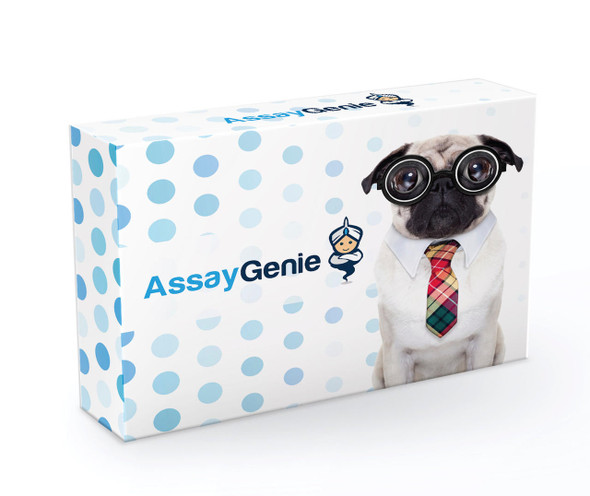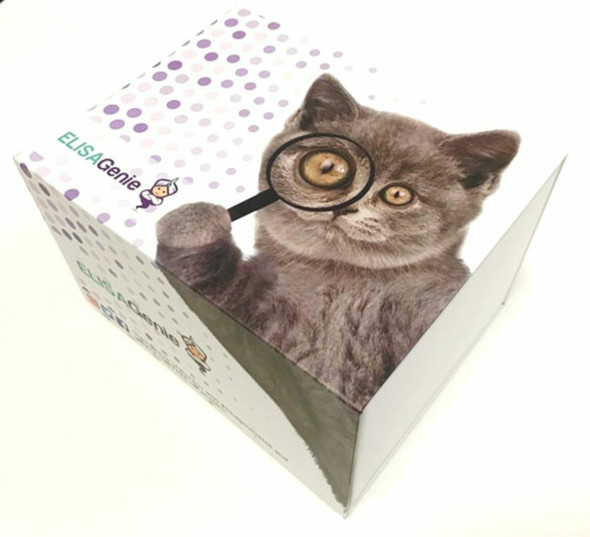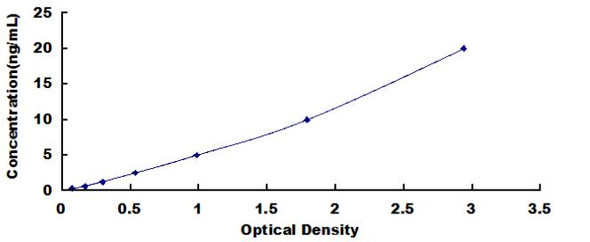Human Bone morphogenetic protein receptor type-2 (BMPR2) ELISA Kit (HUEB0406)
- SKU:
- HUEB0406
- Product Type:
- ELISA Kit
- Size:
- 96 Assays
- Uniprot:
- Q13873
- Range:
- 0.156-10 ng/mL
- ELISA Type:
- Sandwich
- Reactivity:
- Human
Description
Human Bone morphogenetic protein receptor type-2 (BMPR2) ELISA Kit
The Human Bone Morphogenetic Protein Receptor Type 2 (BMPR2) ELISA Kit is a powerful tool for detecting levels of BMPR2 in human samples such as serum, plasma, and cell culture supernatants. This kit offers high sensitivity and specificity, ensuring accurate and reproducible results for a variety of research applications.BMPR2 is a key protein involved in the regulation of bone formation and development, playing a critical role in various physiological processes. Mutations in the BMPR2 gene are associated with conditions such as pulmonary arterial hypertension, making it an important biomarker for studying these diseases and potential therapeutic interventions.
By utilizing the BMPR2 ELISA Kit, researchers can gain valuable insights into the role of BMPR2 in disease pathology and explore new avenues for targeted therapies. With its reliable performance and ease of use, this kit is a valuable asset for any laboratory conducting research in the field of bone morphogenetic protein signaling.
| Product Name: | Human Bone morphogenetic protein receptor type-2 (BMPR2) ELISA Kit |
| SKU: | HUEB0406 |
| Size: | 96T |
| Target: | Human Bone morphogenetic protein receptor type-2 (BMPR2) |
| Synonyms: | Bone morphogenetic protein receptor type II, BMP type II receptor, BMP type-2 receptor, PPH1 |
| Assay Type: | Sandwich |
| Detection Method: | ELISA |
| Reactivity: | Human |
| Detection Range: | 0.156-10ng/mL |
| Sensitivity: | 0.082ng/mL |
| Intra CV: | 5.7% | ||||||||||||||||||||
| Inter CV: | 7.8% | ||||||||||||||||||||
| Linearity: |
| ||||||||||||||||||||
| Recovery: |
| ||||||||||||||||||||
| Function: | On ligand binding, forms a receptor complex consisting of two type II and two type I transmembrane serine/threonine kinases. Type II receptors phosphorylate and activate type I receptors which autophosphorylate, then bind and activate SMAD transcriptional regulators. Binds to BMP7, BMP2 and, less efficiently, BMP4. Binding is weak but enhanced by the presence of type I receptors for BMPs. Mediates induction of adipogenesis by GDF6. |
| Uniprot: | Q13873 |
| Sample Type: | Serum, plasma, tissue homogenates, cell culture supernates and other biological fluids |
| Specificity: | Natural and recombinant human Bone morphogenetic protein receptor type-2 |
| Sub Unit: | Interacts with GDF5. |
| Subcellular Location: | Cell membrane Single-pass type I membrane protein |
| Storage: | Please see kit components below for exact storage details |
| Note: | For research use only |
| UniProt Protein Function: | BMPR2: a serine/threonine-protein kinase receptor for bone morphogenetic protein (BMP). Binds to BMP-7, BMP-2 and, less efficiently, BMP-4. Binding is weak but enhanced by the presence of type I receptors for BMPs. On ligand binding, forms a receptor complex consisting of two type II and two type I transmembrane serine/threonine kinases. Type II receptors phosphorylate and activate type I receptors which autophosphorylate, then bind and activate SMAD transcriptional regulators. Defects in BMPR2 are the cause of primary pulmonary hypertension (PPH1), a weakly penetrant dominant disorder, associated with lesions in pulmonary arterioles, elevated pulmonary arterial pressure, and right ventricular failure. |
| UniProt Protein Details: | Protein type:EC 2.7.11.30; Kinase, protein; Cell cycle regulation; Protein kinase, TKL; Membrane protein, integral; Protein kinase, Ser/Thr (receptor); TKL group; STKR family; Type2 subfamily Chromosomal Location of Human Ortholog: 2q33-q34 Cellular Component: extracellular space; cell surface; cell soma; integral to plasma membrane; apical plasma membrane; dendrite; cytoplasm; plasma membrane; basal plasma membrane; caveola Molecular Function:transforming growth factor beta receptor activity; protein binding; growth factor binding; metal ion binding; activin receptor activity, type II; ATP binding; receptor signaling protein serine/threonine kinase activity Biological Process: limb development; transcription from RNA polymerase II promoter; regulation of lung blood pressure; activin receptor signaling pathway; protein amino acid phosphorylation; anterior/posterior pattern formation; BMP signaling pathway; proteoglycan biosynthetic process; lymphangiogenesis; transmembrane receptor protein serine/threonine kinase signaling pathway; positive regulation of BMP signaling pathway; negative regulation of systemic arterial blood pressure; chondrocyte development; positive regulation of bone mineralization; cellular response to starvation; negative regulation of vasoconstriction; regulation of cell proliferation; positive regulation of osteoblast differentiation; mesoderm formation; positive regulation of axon extension involved in axon guidance; positive regulation of endothelial cell proliferation; blood vessel remodeling; brain development; negative regulation of cell growth; vascular endothelial growth factor receptor signaling pathway; alveolus development Disease: Pulmonary Venoocclusive Disease 1, Autosomal Dominant; Pulmonary Hypertension, Primary, 1 |
| NCBI Summary: | This gene encodes a member of the bone morphogenetic protein (BMP) receptor family of transmembrane serine/threonine kinases. The ligands of this receptor are BMPs, which are members of the TGF-beta superfamily. BMPs are involved in endochondral bone formation and embryogenesis. These proteins transduce their signals through the formation of heteromeric complexes of two different types of serine (threonine) kinase receptors: type I receptors of about 50-55 kD and type II receptors of about 70-80 kD. Type II receptors bind ligands in the absence of type I receptors, but they require their respective type I receptors for signaling, whereas type I receptors require their respective type II receptors for ligand binding. Mutations in this gene have been associated with primary pulmonary hypertension, both familial and fenfluramine-associated, and with pulmonary venoocclusive disease. [provided by RefSeq, Jul 2008] |
| UniProt Code: | Q13873 |
| NCBI GenInfo Identifier: | 15451916 |
| NCBI Gene ID: | 659 |
| NCBI Accession: | NP_001195.2 |
| UniProt Secondary Accession: | Q13873,Q16569, Q4ZG08, Q53SA5, Q585T8, |
| UniProt Related Accession: | Q13873 |
| Molecular Weight: | 115,201 Da |
| NCBI Full Name: | bone morphogenetic protein receptor type-2 |
| NCBI Synonym Full Names: | bone morphogenetic protein receptor, type II (serine/threonine kinase) |
| NCBI Official Symbol: | BMPR2 |
| NCBI Official Synonym Symbols: | BMR2; PPH1; BMPR3; BRK-3; T-ALK; BMPR-II |
| NCBI Protein Information: | bone morphogenetic protein receptor type-2; BMPR-2; BMP type-2 receptor; BMP type II receptor; type II activin receptor-like kinase; bone morphogenetic protein receptor type II; type II receptor for bone morphogenetic protein-4 |
| UniProt Protein Name: | Bone morphogenetic protein receptor type-2 |
| UniProt Synonym Protein Names: | Bone morphogenetic protein receptor type II |
| Protein Family: | Bone morphogenetic protein receptor |
| UniProt Gene Name: | BMPR2 |
| UniProt Entry Name: | BMPR2_HUMAN |
| Component | Quantity (96 Assays) | Storage |
| ELISA Microplate (Dismountable) | 8×12 strips | -20°C |
| Lyophilized Standard | 2 | -20°C |
| Sample Diluent | 20ml | -20°C |
| Assay Diluent A | 10mL | -20°C |
| Assay Diluent B | 10mL | -20°C |
| Detection Reagent A | 120µL | -20°C |
| Detection Reagent B | 120µL | -20°C |
| Wash Buffer | 30mL | 4°C |
| Substrate | 10mL | 4°C |
| Stop Solution | 10mL | 4°C |
| Plate Sealer | 5 | - |
Other materials and equipment required:
- Microplate reader with 450 nm wavelength filter
- Multichannel Pipette, Pipette, microcentrifuge tubes and disposable pipette tips
- Incubator
- Deionized or distilled water
- Absorbent paper
- Buffer resevoir
*Note: The below protocol is a sample protocol. Protocols are specific to each batch/lot. For the correct instructions please follow the protocol included in your kit.
Allow all reagents to reach room temperature (Please do not dissolve the reagents at 37°C directly). All the reagents should be mixed thoroughly by gently swirling before pipetting. Avoid foaming. Keep appropriate numbers of strips for 1 experiment and remove extra strips from microtiter plate. Removed strips should be resealed and stored at -20°C until the kits expiry date. Prepare all reagents, working standards and samples as directed in the previous sections. Please predict the concentration before assaying. If values for these are not within the range of the standard curve, users must determine the optimal sample dilutions for their experiments. We recommend running all samples in duplicate.
| Step | |
| 1. | Add Sample: Add 100µL of Standard, Blank, or Sample per well. The blank well is added with Sample diluent. Solutions are added to the bottom of micro ELISA plate well, avoid inside wall touching and foaming as possible. Mix it gently. Cover the plate with sealer we provided. Incubate for 120 minutes at 37°C. |
| 2. | Remove the liquid from each well, don't wash. Add 100µL of Detection Reagent A working solution to each well. Cover with the Plate sealer. Gently tap the plate to ensure thorough mixing. Incubate for 1 hour at 37°C. Note: if Detection Reagent A appears cloudy warm to room temperature until solution is uniform. |
| 3. | Aspirate each well and wash, repeating the process three times. Wash by filling each well with Wash Buffer (approximately 400µL) (a squirt bottle, multi-channel pipette,manifold dispenser or automated washer are needed). Complete removal of liquid at each step is essential. After the last wash, completely remove remaining Wash Buffer by aspirating or decanting. Invert the plate and pat it against thick clean absorbent paper. |
| 4. | Add 100µL of Detection Reagent B working solution to each well. Cover with the Plate sealer. Incubate for 60 minutes at 37°C. |
| 5. | Repeat the wash process for five times as conducted in step 3. |
| 6. | Add 90µL of Substrate Solution to each well. Cover with a new Plate sealer and incubate for 10-20 minutes at 37°C. Protect the plate from light. The reaction time can be shortened or extended according to the actual color change, but this should not exceed more than 30 minutes. When apparent gradient appears in standard wells, user should terminatethe reaction. |
| 7. | Add 50µL of Stop Solution to each well. If color change does not appear uniform, gently tap the plate to ensure thorough mixing. |
| 8. | Determine the optical density (OD value) of each well at once, using a micro-plate reader set to 450 nm. User should open the micro-plate reader in advance, preheat the instrument, and set the testing parameters. |
| 9. | After experiment, store all reagents according to the specified storage temperature respectively until their expiry. |
When carrying out an ELISA assay it is important to prepare your samples in order to achieve the best possible results. Below we have a list of procedures for the preparation of samples for different sample types.
| Sample Type | Protocol |
| Serum | If using serum separator tubes, allow samples to clot for 30 minutes at room temperature. Centrifuge for 10 minutes at 1,000x g. Collect the serum fraction and assay promptly or aliquot and store the samples at -80°C. Avoid multiple freeze-thaw cycles. If serum separator tubes are not being used, allow samples to clot overnight at 2-8°C. Centrifuge for 10 minutes at 1,000x g. Remove serum and assay promptly or aliquot and store the samples at -80°C. Avoid multiple freeze-thaw cycles. |
| Plasma | Collect plasma using EDTA or heparin as an anticoagulant. Centrifuge samples at 4°C for 15 mins at 1000 × g within 30 mins of collection. Collect the plasma fraction and assay promptly or aliquot and store the samples at -80°C. Avoid multiple freeze-thaw cycles. Note: Over haemolysed samples are not suitable for use with this kit. |
| Urine & Cerebrospinal Fluid | Collect the urine (mid-stream) in a sterile container, centrifuge for 20 mins at 2000-3000 rpm. Remove supernatant and assay immediately. If any precipitation is detected, repeat the centrifugation step. A similar protocol can be used for cerebrospinal fluid. |
| Cell culture supernatant | Collect the cell culture media by pipette, followed by centrifugation at 4°C for 20 mins at 1500 rpm. Collect the clear supernatant and assay immediately. |
| Cell lysates | Solubilize cells in lysis buffer and allow to sit on ice for 30 minutes. Centrifuge tubes at 14,000 x g for 5 minutes to remove insoluble material. Aliquot the supernatant into a new tube and discard the remaining whole cell extract. Quantify total protein concentration using a total protein assay. Assay immediately or aliquot and store at ≤ -20 °C. |
| Tissue homogenates | The preparation of tissue homogenates will vary depending upon tissue type. Rinse tissue with 1X PBS to remove excess blood & homogenize in 20ml of 1X PBS (including protease inhibitors) and store overnight at ≤ -20°C. Two freeze-thaw cycles are required to break the cell membranes. To further disrupt the cell membranes you can sonicate the samples. Centrifuge homogenates for 5 mins at 5000xg. Remove the supernatant and assay immediately or aliquot and store at -20°C or -80°C. |
| Tissue lysates | Rinse tissue with PBS, cut into 1-2 mm pieces, and homogenize with a tissue homogenizer in PBS. Add an equal volume of RIPA buffer containing protease inhibitors and lyse tissues at room temperature for 30 minutes with gentle agitation. Centrifuge to remove debris. Quantify total protein concentration using a total protein assay. Assay immediately or aliquot and store at ≤ -20 °C. |
| Breast Milk | Collect milk samples and centrifuge at 10,000 x g for 60 min at 4°C. Aliquot the supernatant and assay. For long term use, store samples at -80°C. Minimize freeze/thaw cycles. |








